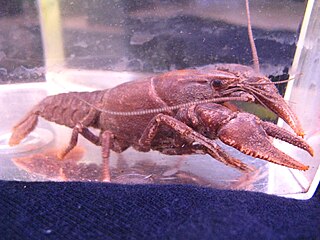Cambarus batchi, the bluegrass crayfish, is a species of crayfish in the family Cambaridae. It is endemic to Kentucky, known as the "Bluegrass State" which lead to the common name.
Cambarus cymatilis, the Conasauga blue burrower is a species of burrowing crayfish in the family Cambaridae. It is native to Tennessee and Georgia in the United States. The common name refers to the Conasauga River.
Cambarus deweesae, the valley flame crayfish, is a species of crayfish in the family Cambaridae. It is found in Kentucky and Tennessee.

Cambarus georgiae, the Little Tennessee crayfish, is a species of crayfish in the family Cambaridae. It is found in Georgia and North Carolina.
Cambarus harti, the Piedmont blue burrower, is a species of burrowing crayfish in the family Cambaridae. It is endemic to Georgia in the United States. The common name refers to the Piedmont plateau region.
Cambarus pristinus, the pristine crayfish, is a species of crayfish in the family Cambaridae. It is endemic to Tennessee.
Cambarus subterraneus, the Delaware County cave crayfish, is a species of crayfish in the family Cambaridae. It has been found only in three caves in Delaware County, Oklahoma.
Cambarus tartarus, the Oklahoma cave crayfish, is a species of crayfish in the family Cambaridae. It is endemic to two caves in Delaware County, Oklahoma in the United States.

Cambarus unestami, the blackbarred crayfish, is a species of crayfish in the family Cambaridae. It is native to Alabama and Georgia in the United States.
Cambarus williami, the Brawleys Fork crayfish, is a species of crayfish in the family Cambaridae. It is endemic to Tennessee.

Creaserinus burrisi, the burrowing bog crayfish, is a species of crayfish in the family Cambaridae. It is found in a limited range in southeastern Mississippi and southwestern Alabama.
Creaserinus danielae, the speckled burrowing crayfish, is a species of crayfish in the family Cambaridae. It is found in Mississippi, Alabama, Louisiana, and Florida.
Creaserinus gilpini, the Jefferson County crayfish, is a species of crayfish in the family Cambaridae. It is endemic to Arkansas.
Creaserinus gordoni, the Camp Shelby burrowing crayfish, is a species of crayfish in the family Cambaridae. It is found in Mississippi.
Fallicambarus petilicarpus, the slenderwrist burrowing crayfish, is a species of crayfish in the family Cambaridae. It is found in southern Arkansas and northern Louisiana.
Fallicambarus strawni, the saline burrowing crayfish, is a species of crayfish in the family Cambaridae. It is found in southeastern Oklahoma and western Arkansas.
Hobbseus orconectoides, the Oktibbeha riverlet crayfish, is a species of crayfish in the family Cambaridae. It is endemic to Mississippi in the United States.
Hobbseus valleculus, the Choctaw riverlet crayfish, is a species of crayfish in the family Cambaridae. It is endemic to Mississippi in the United States.

Fallicambarus is a genus of crayfish in the family Cambaridae from the United States and Canada. It includes 12 species, of which one is on the IUCN Red List as a vulnerable species (VU) and one as an endangered species (EN). The species of this genus are all restricted to three states or fewer, from Texas and Oklahoma east to Florida.
Cambarus gentryi, the linear cobalt crayfish, is a small burrowing species of crayfish in the family Cambaridae, notable for its blue carapace. It is endemic to Tennessee in the United States.





